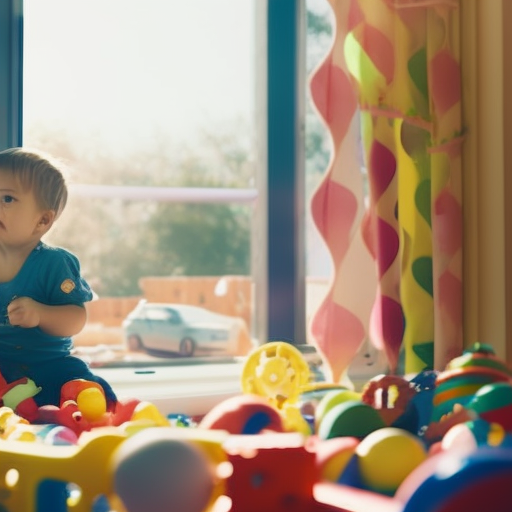"Cherishing Little Steps - A Haven for Baby and Family Journeys"
Coping With Toddler Mood Swings
Parenthood is like navigating a turbulent sea, and your toddler’s mood swings are the unpredictable waves that can sometimes catch you off guard. Just when you think you have found your footing, their emotions can shift from sunny skies to stormy clouds in an instant.
It’s important to remember that you are not alone in this journey, and there are strategies to help you weather the storm. So, how do you cope with these toddler mood swings?
Let’s explore some effective techniques that can bring a sense of calm and stability to your little one’s ever-changing emotional landscape.
Key Takeaways
- Recognize developmental milestones
- Identify triggers for toddler mood swings
- Create a calm and consistent environment
- Teach emotional regulation skills
Understanding Toddler Emotions
Understanding your toddler’s emotions can be a challenging yet essential aspect of parenting. As your little one grows and develops, they experience a wide range of emotions that they may struggle to express. Recognizing developmental milestones and supporting their social-emotional development can help you navigate these emotional roller coasters.
At this stage, your toddler is learning to understand and regulate their emotions. They may have difficulty controlling their impulses, leading to frequent mood swings. It’s crucial to remember that these mood swings are a normal part of their development. By recognizing and acknowledging their emotions, you can help them feel understood and supported.
One way to support your toddler’s emotional development is by providing a safe and nurturing environment. Create a warm and loving atmosphere where they feel comfortable expressing their feelings. Encourage them to talk about what they’re experiencing, even if their vocabulary is limited. By validating their emotions and offering empathy, you can help them develop a healthy emotional intelligence.
Additionally, understanding and celebrating your toddler’s developmental milestones can contribute to their emotional well-being. Each milestone they achieve, whether it’s taking their first steps or saying their first words, brings them a sense of accomplishment and boosts their self-esteem. By recognizing and praising their achievements, you’re nurturing their emotional growth.
Recognizing Triggers for Mood Swings

As your toddler continues to navigate their emotional development, it’s important to be aware of the triggers that can lead to their mood swings. Recognizing patterns and understanding what sets off these meltdowns can help you effectively manage your toddler’s emotions and create a calmer environment for both of you.
Every child is unique, and what triggers mood swings in one toddler may not affect another. However, there are some common triggers to be mindful of. Changes in routine or environment, hunger, tiredness, overstimulation, and frustration are often key culprits. By observing your child closely, you can start to identify recurring situations or events that consistently lead to mood swings.
Once you recognize these triggers, you can take proactive steps to minimize their impact. For example, maintaining a consistent daily routine, ensuring your toddler is well-rested and well-fed, and creating a calm and quiet environment can help prevent mood swings from occurring in the first place. Additionally, teaching your child healthy coping mechanisms, such as deep breathing or taking a break, can provide them with tools to manage their emotions effectively.
Creating a Calm and Consistent Environment

To create a calm and consistent environment for your toddler, it’s important to establish predictable routines and provide a soothing atmosphere that promotes emotional stability. Creating a peaceful space for your little one can make a big difference in their mood and overall well-being. Start by setting up a designated area in your home where your toddler can unwind and relax. This space should be free from distractions and clutter, allowing your child to feel safe and at ease. Fill the area with soft pillows, cozy blankets, and calming colors to create a serene atmosphere.
In addition to creating a peaceful space, promoting relaxation techniques can also help your toddler manage their mood swings. Encourage them to engage in activities that promote relaxation, such as deep breathing exercises or gentle stretching. Incorporate soothing music or nature sounds into their routine to help them unwind.
Consistency is key when it comes to creating a calm environment for your toddler. Stick to a daily routine that includes regular mealtimes, nap times, and bedtime. Predictability brings a sense of security for children, which can help them regulate their emotions more effectively.
Teaching Emotional Regulation Skills

Now that you have established a calm and consistent environment for your toddler, it’s time to help them develop essential emotional regulation skills. Teaching your little one how to manage their emotions is an important step in their development, as it will enable them to navigate their feelings in a healthy and constructive manner. Here are four effective strategies to assist you in teaching your toddler these crucial skills:
-
Teach self-soothing techniques: Encourage your child to find coping mechanisms that help them calm down when they’re feeling overwhelmed. This could be taking deep breaths, counting to ten, or hugging a favorite stuffed animal.
-
Promote mindfulness activities: Engage your toddler in simple mindfulness exercises, such as guided breathing or sensory play. These activities can help them stay present, recognize their emotions, and respond to them in a positive way.
-
Validate their emotions: Let your child know that it’s okay to feel a wide range of emotions. By acknowledging their feelings and offering words of understanding, you help them develop emotional intelligence and learn that their emotions are valid.
-
Model emotional regulation: Be a role model for your toddler by managing your own emotions in a healthy way. When they see you staying calm and composed during challenging situations, they’ll learn to do the same.
Using Positive Reinforcement Techniques

Positive reinforcement techniques can be a powerful tool in helping your toddler develop emotional regulation skills and navigate their ever-changing moods. By using positive reinforcement strategies, you can effectively discipline your child while also promoting their self-esteem and positive behavior.
One effective positive reinforcement technique is offering praise and rewards. When your toddler displays good behavior or manages their emotions well, acknowledge and praise them for their efforts. This not only boosts their confidence but also reinforces the desired behavior. You can also use small rewards, such as stickers or a special treat, to further motivate and encourage positive actions.
Another effective technique is using a reward chart. Create a chart with specific goals or tasks that you want your toddler to achieve, such as sharing toys or using their words instead of tantrums. Each time they meet a goal, mark it on the chart and reward them accordingly. This visual representation of their progress can be motivating and help them understand their own growth and development.
Remember, consistency is key when using positive reinforcement techniques. Be clear about your expectations and consistently reward and praise your child when they meet them. This will help them understand what behavior is desired and encourage them to continue practicing effective emotional regulation skills.
Incorporating positive reinforcement techniques into your parenting approach can help your toddler develop important emotional regulation skills and manage their moods more effectively. By using these effective discipline techniques, you can create a positive and supportive environment that fosters your child’s emotional growth and well-being.
Establishing a Predictable Routine

Establishing a consistent and predictable routine is essential for helping your toddler navigate their mood swings and develop a sense of stability and security. Toddlers thrive on routine because it provides them with a sense of order and predictability in their lives.
Here are some tips to help you establish a routine that can support your little one’s emotional well-being:
-
Develop Bedtime Rituals: Create a calming and soothing bedtime routine that signals to your toddler that it’s time to wind down and prepare for sleep. This can include activities such as a warm bath, reading a bedtime story, or singing a lullaby. These rituals can help your toddler relax and feel secure, making it easier for them to fall asleep and stay asleep.
-
Incorporate Transition Activities: Toddlers often have a hard time transitioning from one activity to another, which can trigger mood swings. To ease these transitions, incorporate transition activities. For example, before moving on to a new activity, engage your toddler in a short game or a fun song. This can help them shift their focus and make the transition smoother.
-
Create a Daily Schedule: Having a daily schedule can provide your toddler with a sense of structure and predictability. Plan regular meal times, play times, and nap times. Be consistent with the timing as much as possible, as this can help your toddler feel secure and reduce the likelihood of mood swings.
-
Be Flexible: While routines are important, it’s also crucial to be flexible. Toddlers are known for their unpredictable nature, and sometimes unexpected events or situations may disrupt the routine. Embrace these moments as opportunities for growth and learning, and try to adapt the routine accordingly.
Encouraging Open Communication
To foster a strong bond and promote emotional well-being, it’s important to create an environment that encourages open communication with your toddler. Effective communication plays a vital role in understanding your child’s needs, feelings, and thoughts. Building trust through open dialogue helps your toddler feel safe and supported, which in turn enhances their emotional development.
Encouraging open communication begins by actively listening to your toddler. Pay attention to their words, gestures, and facial expressions. Show genuine interest and respond with empathy and understanding. This validates their emotions and encourages them to express themselves more freely.
Creating a safe space for communication is essential. Find a quiet and comfortable place where you can talk without distractions. Make sure your toddler knows that they can share their thoughts and feelings without fear of judgment or punishment. Encourage them to ask questions, express their concerns, and share their experiences.
Using age-appropriate language is crucial when communicating with your toddler. Keep your sentences simple and use words that they can understand. Ask open-ended questions to encourage them to share more about their experiences and feelings.
Practicing Patience and Empathy

By practicing patience and empathy, you can create a supportive environment that allows your toddler to navigate their mood swings with understanding and compassion. Here are some ways you can cultivate these qualities and help your child develop resilience while setting appropriate boundaries:
-
Stay calm: When your toddler is experiencing a mood swing, it’s important to remain calm and composed. Your reaction sets the tone for their emotional regulation. Take deep breaths and remind yourself that their behavior is a normal part of their development.
-
Validate their emotions: Let your child know that it’s okay to feel upset or frustrated. Use phrases like, ‘I understand you’re feeling angry right now.’ This shows them that you acknowledge their emotions and helps them learn to identify and express their feelings.
-
Be present and attentive: Give your toddler your full attention when they’re going through a mood swing. Show them that you’re there for them and that their emotions matter. This helps build trust and a sense of security.
-
Set clear boundaries: While it’s important to be empathetic, it’s equally important to set limits. Establish consistent rules and expectations for behavior. This helps your child understand what’s acceptable and what’s not, which in turn helps them feel secure and confident.
Providing Healthy Outlets for Emotions

Help your toddler find healthy ways to express their emotions and cope with mood swings. Teaching coping skills and promoting emotional well-being are essential in helping your little one navigate their emotions effectively. Toddlers often struggle with expressing their feelings in a constructive manner, which can lead to tantrums or meltdowns. By providing them with healthy outlets for their emotions, you can help them develop the necessary skills to handle their mood swings in a positive way.
One important way to promote emotional well-being is by encouraging your toddler to engage in activities that allow them to express their emotions freely. Artistic activities such as drawing, painting, or playing with clay can provide a creative outlet for their feelings. Encourage them to talk about their artwork and what emotions they were experiencing while creating it. This not only helps them identify and understand their emotions but also allows them to express themselves in a safe and constructive manner.
Physical activities can also be beneficial in helping your toddler cope with mood swings. Running, jumping, or dancing can help release pent-up energy and emotions. Additionally, engaging in sensory play, such as playing with sand or water, can have a calming effect on their emotions.
Remember to provide a supportive and nurturing environment where your toddler feels comfortable expressing their emotions. Show empathy and understanding when they’re upset or frustrated, and encourage them to talk about what they’re feeling. By teaching them healthy coping skills and promoting emotional well-being, you’re equipping your toddler with valuable tools to navigate their emotions in a positive and constructive way.
Seeking Professional Help When Needed

When supporting your toddler through their mood swings, it’s important to recognize that there may be times when seeking professional help is necessary. Remember, you aren’t alone in this journey, and there are professionals who can provide the support and guidance needed to navigate through these challenging times.
Here are some therapy options that may be beneficial for your toddler:
-
Play Therapy: This type of therapy allows your child to express their emotions and experiences through play. A trained therapist will observe and interact with your toddler, helping them to develop coping strategies and explore their feelings in a safe and supportive environment.
-
Parent-Child Interaction Therapy: This therapy focuses on improving the parent-child relationship and communication. A therapist will guide you in learning effective ways to interact with your toddler, manage their behavior, and strengthen your bond.
-
Cognitive-Behavioral Therapy: This approach helps your toddler identify and change negative thought patterns and behaviors. A therapist will work with your child to develop positive coping skills and strategies for managing their emotions.
-
Family Therapy: This type of therapy involves the entire family and aims to improve communication and understanding among family members. It can be beneficial in addressing any underlying family dynamics that may be contributing to your toddler’s mood swings.
Frequently Asked Questions
How Do I Discipline My Toddler When They Have a Mood Swing?
When your toddler has a mood swing, it can be challenging to discipline them. However, there are effective approaches to managing tantrums. Stay calm, set clear boundaries, offer comfort, and use positive reinforcement to encourage better behavior.
What Are Some Common Triggers for Toddler Mood Swings?
When it comes to toddler mood swings, hunger and tiredness are common triggers. It’s important to recognize these signs and address them promptly to help your little one navigate their emotions more smoothly.
How Can I Encourage My Toddler to Talk About Their Emotions?
You can encourage your toddler to talk about their emotions by creating a safe and welcoming environment for them to express themselves. Building a strong emotional bond with your child is key to helping them open up and share their feelings.
Are There Any Specific Techniques to Teach My Toddler Emotional Regulation Skills?
To teach your toddler emotional regulation skills, try using techniques like deep breathing exercises, providing a calm and consistent environment, and using positive reinforcement. These strategies can help manage their mood swings effectively.
When Should I Seek Professional Help for My Toddler’s Mood Swings?
If your little one’s mood swings seem extreme or interfere with their daily life, seeking professional help is a wise choice. Early intervention can provide the support and guidance needed for their emotional well-being.
Conclusion
As you navigate the wild ride of toddlerhood, remember that your little one’s mood swings are a normal part of their development. Just like a roller coaster, their emotions can go up and down in a heartbeat.
But with understanding, patience, and a consistent environment, you can help them find their emotional balance. Picture yourself as their guide, holding their hand as they navigate the twists and turns.
Together, you’ll weather the storm and come out stronger on the other side. Keep up the amazing work!



I don’t think the title of your article matches the content lol. Just kidding, mainly because I had some doubts after reading the article.